
Miners pulling up lazy tourists to the rim of Kawah Ijen (Ijen Volcano), East Java, Indonesia on September 21, 2017. They will earn as much as they would bring down a load of sulfur. Nomadic Explorer, Cultural Lifestyle Photographer Claudio Sieber captured striking images of miners working at Ijen volcanic range in East Java, Indonesia. The sulphur miners risk their lives daily as they climb the active volcano carrying heavy loads, which they sell to sugar refineries. Shortly after midnight curious tourists are flocking in hundreds through the gate of Ijen's foothills to be right on time, driven by the images others took before them. Kawah Ijen is the one of the world's largest acidic volcanic crater lake; famous for its turquoise color as well as the unreal atmosphere it offers during darkness. A dusty path zigzags 3 kilometers up to the crater rim. This doesn't mean anything challenging; in particular, special sights have to be deserved anyway. The irritating smell of sulfur announces the near of the crater's existence. Arriving on the crater's rim the reward for the torture becomes visible. Blue fire darts its tongues through the fumes of sulfur dioxide. Somehow, the spectacle isn't as romantic as expected, since it is also the rough working space of approx. 150 sulfur miners who start their shift at 1 am. Lately, harvesting the abundance of devil's gold received international attention. This did obviously not really improve a miner's lifestyle; neither did it contribute to a better wage. (Photo by Claudio Sieber/Barcroft Images)
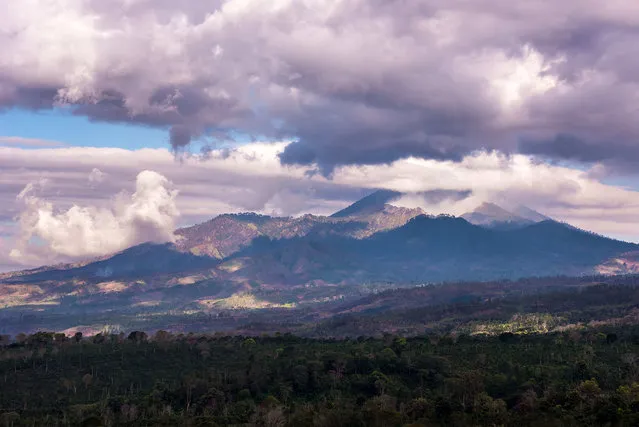
Photographer Claudio Sieber captured striking images of miners working at Ijen volcanic range in East Java, Indonesia on September 21, 2017. (Photo by Claudio Sieber/Barcroft Images)

Ijen Volcano Crater lake during sunrise in East Java, Indonesia on September 21, 2017. Pipes had been installed at the crater to lead the vaporizing sulfur down to a collecting point, where the miners are cracking the hardened sulfur. (Photo by Claudio Sieber/Barcroft Images)

Supeno, the miner can't afford a trolley. He is now weighing the sulfur, today he will ear around 7 USD. Because the salary isn't enough to feed his family of 4 properly. He still has to carry the load of 80kg the whole way of 3km downhill. It will take him about an 2-3 hours. Trolleys cost about 2 million Rupiah (150 USD). Not all of the miners can afford one. Most of the trolleys are coming from donations. (Photo by Claudio Sieber/Barcroft Images)

A miner is molding sulfur in turtle or other shapes to sell it to tourists in East Java, Indonesia on September 21, 2017. 150 miners are working in Ijen. Most of the souvenirs cost about 50'000 Rupiah (4 US Dollars). The crater produces 15 tons of fresh sulfur every day. (Photo by Claudio Sieber/Barcroft Images)

Pipes had been installed at the crater to lead the vaporizing sulfur down to a collecting point, where the miners are cracking the hardened sulfur. Their shift starts at 1 am. Usually it takes them a few attempts because the toxic fumes are swirling unpredictable. Still not all of the miners use gas masks. (Photo by Claudio Sieber/Barcroft Images)

Pipes had been installed at the crater to lead the vaporizing sulfur down to a collecting point, where the miners are cracking the hardened sulfur. (Photo by Claudio Sieber/Barcroft Images)

After cracking the hardened sulfur, the miners put them into bamboo baskets. 70-80 kilo is the average for one go. Some miners might carry up to 120 kilo. Cracked collarbones aren't unusual. When the sun rises they start carrying it up to the craters rim where they parked a trolley. With the trolley they roll up to 3 loads of sulfur down to the checkpoint. The checkpoint is 3 km away. (Photo by Claudio Sieber/Barcroft Images)
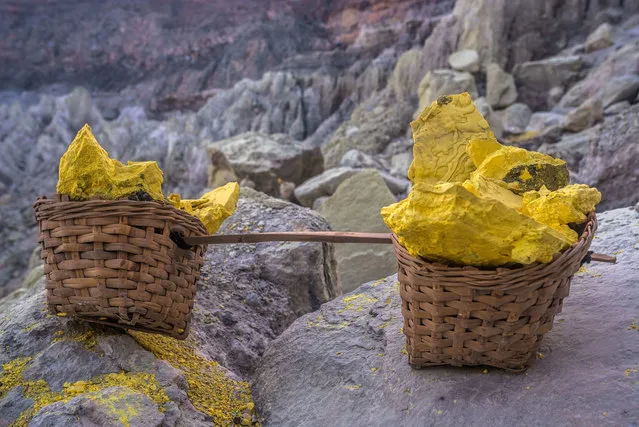
After cracking the hardened sulfur, the miners put them into bamboo baskets. 70-80 kilo is the average for one go. Some miners might carry up to 120 kilo. Cracked collarbones aren't unusual. When the sun rises they start carrying it up to the craters rim where they parked a trolley. With the trolley they roll up to 3 loads of sulfur down to the checkpoint. The checkpoint is 3 km away. (Photo by Claudio Sieber/Barcroft Images)

After cracking the hardened sulfur, the miners put them into bamboo baskets. 70-80 kilo is the average for one go. Some miners might carry up to 120 kilo. Cracked collarbones aren't unusual. When the sun rises they start carrying it up to the craters rim where they parked a trolley. With the trolley they roll up to 3 loads of sulfur down to the checkpoint. The checkpoint is 3 km away. (Photo by Claudio Sieber/Barcroft Images)
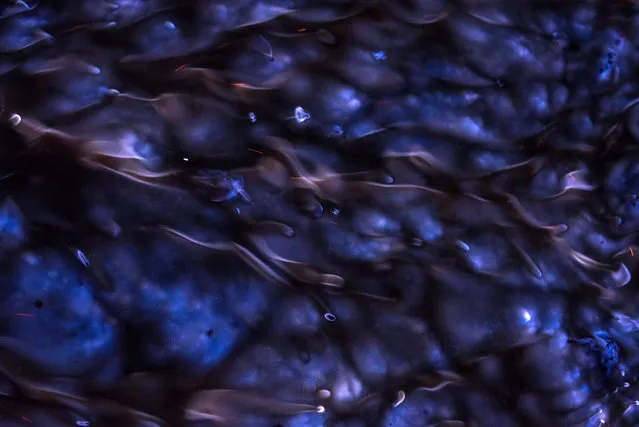
Bromo and Ijen Volcano Kawah Ijen, shortly after midnight on September 21, 2017. Accidentally, highly inflammable sulfur caught fire, the ground starts to burn until a miner comes to extinguish. Sulfur burns with a blue flame with formation of sulfur dioxide, which has a suffocating and irritating odor. (Photo by Claudio Sieber/Barcroft Images)

After cracking the hardened sulfur, the miners put them into bamboo baskets. 70-80 kilo is the average for one go. Some miners might carry up to 120 kilo. Cracked collarbones aren't unusual. When the sun rises they start carrying it up to the craters rim where they parked a trolley. With the trolley they roll up to 3 loads of sulfur down to the checkpoint. The checkpoint is 3 km away. (Photo by Claudio Sieber/Barcroft Images)
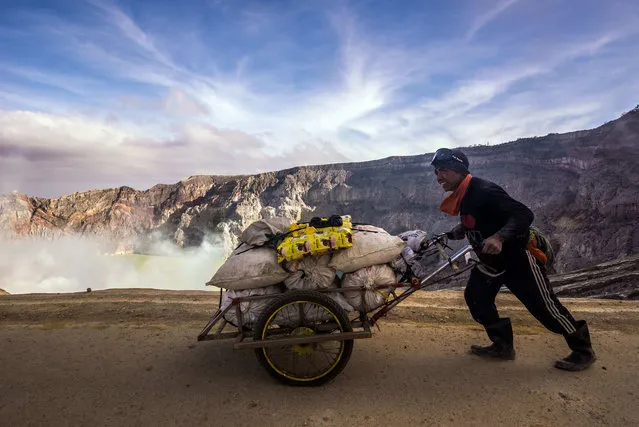
A miner with a full load of sulfur starts rolling down his trolley to the checkpoint – which is 3km downhill. It will take him about an hour. He still had to carry up the load to the rim, roughly 175 vertically up. Trolleys cost about 2 million Rupiah (150 USD). Not all of the miners can afford one. Most of the trolleys are coming from donations. (Photo by Claudio Sieber/Barcroft Images)
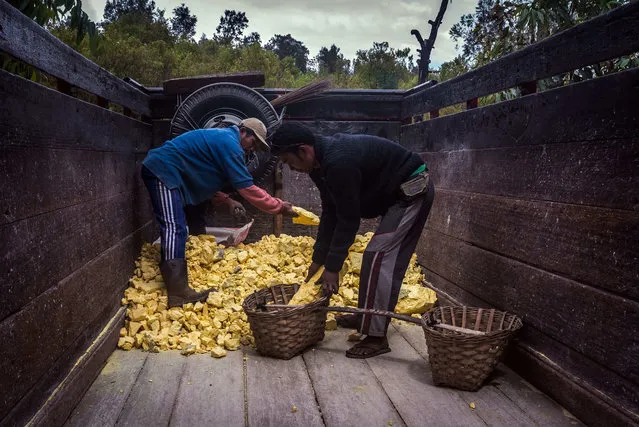
Supeno, the miner can't afford a trolley. He is now weighing the sulfur, today he will ear around 7 USD. Because the salary isn't enough to feed his family of 4 properly. He still has to carry the load of 80kg the whole way of 3km downhill. It will take him about an 2-3 hours. Trolleys cost about 2 million Rupiah (150 USD). Not all of the miners can afford one. Most of the trolleys are coming from donations. (Photo by Claudio Sieber/Barcroft Images)
02 Oct 2017 08:31:00,
post received
0 comments
